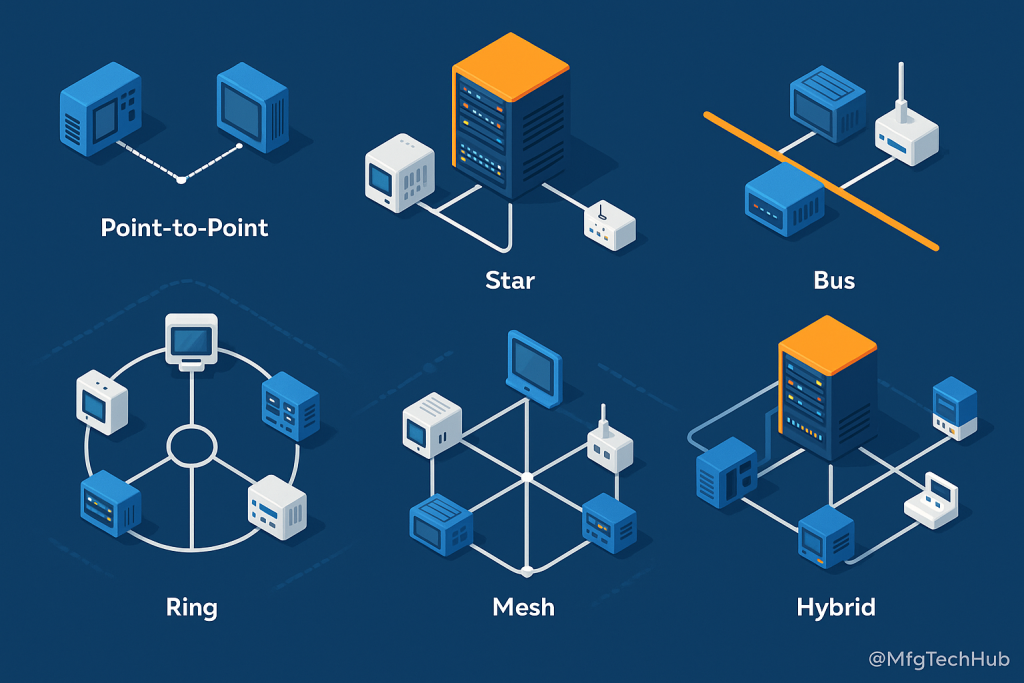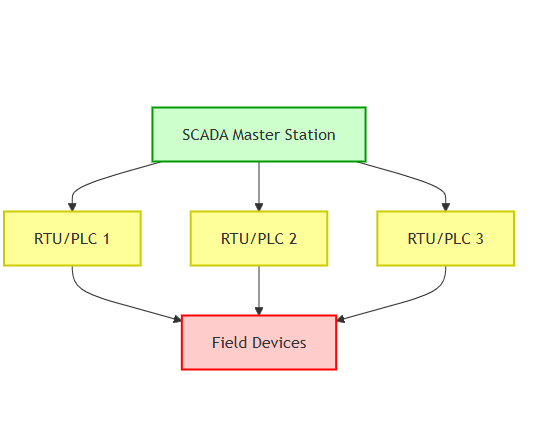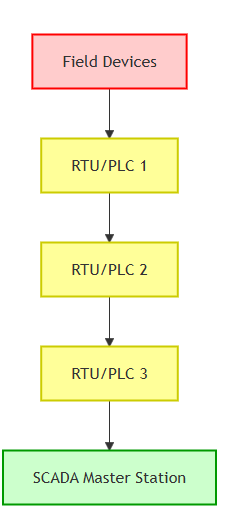SCADA Architecture: Network Topologies
Supervisory Control and Data Acquisition (SCADA) systems rely on robust network topologies to facilitate efficient communication between devices, control centers, and operators. The choice of network topology affects system reliability, scalability, and performance in industrial environments.

What is Network Topology in SCADA?
Network topology refers to the physical and logical structure of how SCADA components (e.g., sensors, RTUs, PLCs, HMIs, and servers) are connected and how data flows between them.
The right topology ensures:
- ✔ Efficient data transmission between field devices and central control units.
- ✔ Scalability for future expansions.
- ✔ Reliability to minimize data loss or communication failures.
- ✔ Redundancy and fault tolerance to ensure continuous operations.
Common SCADA Network Topologies
1. Point-to-Point Topology
Overview: The simplest network configuration where devices communicate directly with each other.
How It Works:
- Each field device (e.g., sensor, PLC) is connected one-to-one with an RTU or SCADA server.
- Communication occurs over a dedicated channel (wired or wireless).
✅ Advantages:
- ✔ Simple and easy to implement.
- ✔ Low cost for small-scale systems.
❌ Disadvantages:
- ✖ Poor scalability—adding more devices requires additional connections.
- ✖ No redundancy—if a link fails, communication is lost.
Use Case: Small SCADA setups like standalone machines in a factory.
2. Star Topology

Overview: A central hub (SCADA server or switch) connects all devices in a star-like structure.
How It Works:
- Field devices (PLCs, RTUs, HMIs) send and receive data via a central SCADA server.
- If one device fails, others remain unaffected.
✅ Advantages:
- ✔ Easy expansion—new devices can be added without affecting the network.
- ✔ Fast communication—data transfer happens directly to the SCADA server.
❌ Disadvantages:
- ✖ The central hub is a single point of failure—if it fails, the entire system goes down.
- ✖ Requires more cabling compared to point-to-point topology.
Use Case: Water distribution networks, smart buildings.
3. Bus Topology

Overview: Devices share a single communication backbone (bus line) for data transmission.
How It Works:
- All devices connect to a single cable (bus).
- Data travels along the bus to reach the intended device.
✅ Advantages:
- ✔ Cost-effective—less cabling needed.
- ✔ Easy to set up for small systems.
❌ Disadvantages:
- ✖ If the main bus fails, the entire network goes down.
- ✖ Performance slows as more devices are added.
Use Case: Legacy SCADA systems in smaller industrial applications.
4. Ring Topology
Overview: Devices are connected in a closed-loop (ring), allowing data to travel in one or both directions.
How It Works:
- Data circulates through the ring until it reaches the intended device.
- If one connection fails, the system can reroute data in the opposite direction.
✅ Advantages:
- ✔ High fault tolerance—data can travel both ways if one link fails.
- ✔ Efficient for continuous data transmission.
❌ Disadvantages:
- ✖ Hard to modify—adding new devices disrupts the network.
- ✖ Slower response time for large networks.
Use Case: Critical infrastructure like electric power grids and pipeline monitoring.
5. Mesh Topology
Overview: Every device connects to multiple other devices, creating multiple data paths for redundancy.
How It Works:
- Devices communicate directly or via intermediate nodes.
- If one path fails, data finds an alternative route.
✅ Advantages:
- ✔ Excellent reliability—ensures continuous operations.
- ✔ Scalable—new devices can be added without major changes.
❌ Disadvantages:
- ✖ Complex setup—requires extensive planning.
- ✖ High cost—requires more communication infrastructure.
Use Case: Large-scale industrial SCADA (e.g., oil refineries, national power grids).
6. Hybrid Topology

Overview: A combination of two or more network topologies to maximize reliability and efficiency.
How It Works:
- A star topology can be used within a ring or mesh network, offering a balance of scalability and fault tolerance.
- Typically used in large industrial SCADA systems.
✅ Advantages:
- ✔ Highly flexible—customizable for specific requirements.
- ✔ Resilient—redundancy ensures uptime even during failures.
❌ Disadvantages:
- ✖ Expensive and complex—requires skilled planning and maintenance.
Use Case: Smart grids, smart cities, industrial automation.
Choosing the Right Network Topology for SCADA
The best topology depends on system size, reliability needs, and cost constraints.
| Factor | Best Topology |
|---|---|
| Small, simple SCADA systems | Point-to-Point, Star |
| Mid-sized systems with moderate redundancy | Star, Bus |
| Large, high-reliability operations | Ring, Mesh, Hybrid |
| Geographically distributed systems | Hybrid (Mesh + Star) |
Key Considerations for SCADA Networking
1. Reliability and Fault Tolerance
🔹 Critical systems (power grids, pipelines) need ring or mesh topology for redundancy.
🔹 Less critical applications can use star or bus topologies to reduce costs.
2. Scalability
🔹 Growing industries should use hybrid or mesh networks for easy expansion.
3. Communication Speed
🔹 High-speed applications (manufacturing, oil & gas) benefit from star or ring networks.
4. Security
🔹 SCADA systems should encrypt data transmission and restrict network access to prevent cyber threats.
Real-World Applications of SCADA Network Topologies
1. Smart Grids (Power Distribution)
Network Used: Mesh Topology
📌 Why? Multiple routes ensure grid reliability and fault tolerance.
2. Water Treatment Plants
Network Used: Star Topology
📌 Why? Centralized SCADA servers efficiently monitor and control pumps, valves, and chemical dosing.
3. Oil & Gas Pipelines
Network Used: Ring Topology
📌 Why? Ensures continuous data flow with automatic failover protection.
Future Trends in SCADA Networking
🔹 5G & LPWAN Integration – Faster, more reliable communication for remote SCADA systems.
🔹 Edge Computing – Reducing latency by processing data closer to field devices.
🔹 Blockchain Security – Secure SCADA networks from cyber threats.
🔹 AI-Optimized Networks – Predict and self-optimize network performance.
Selecting the right network topology is crucial for SCADA performance, reliability, and scalability. Whether using a simple star network for a small factory or a complex mesh topology for a nationwide power grid, understanding SCADA networking ensures efficient operations and long-term sustainability.
